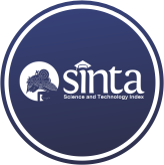Analisis Pola Transaksi Pelanggan Menggunakan Algoritme Apriori
(1) Sistem Informasi, Universitas Teknokrat Indonesia
(2) Informatika, Universitas Teknokrat Indonesia
(3) Sistem Informasi, Universitas Teknokrat Indonesia
(*) Corresponding Author
Abstract
Full Text:
PDFReferences
S. Styawati and F. Ariany, “Sistem Monitoring Tumbuh Kembang Balita/Batita di Tengah Covid-19 Berbasis Mobile,” J. Inform. Univ. Pamulang, vol. 5, no. 4, p. 490, 2021, doi: 10.32493/informatika.v5i4.7067.
S. Alim and P. P. Lestari, “Sistem Pakar Diagnosa Penyakit Tanaman Kakao Menggunakan Metode Certainty Factor Pada Kelompok Tani PT Olam Indonesia ( COCOA ) Cabang Lampung,” vol. 1, no. 4, pp. 26–31, 2020.
Y. Rahmanto, “Rancang Bangun Sistem Informasi Manajemen Koperasi Menggunakan Metode Web Engineering ( Studi Kasus : Primkop Kartika Gatam ),” vol. 2, no. 1, pp. 24–30, 2021.
I. B. G. Sarasvananda, C. Anwar, and ..., “analisis survei kepuasan masyarakat menggunkan pendekatan E-CRM (Studi Kasus: BP3TKI Lampung),” … dan Sist. Inf., vol. 2, no. 1, pp. 1–9, 2021, [Online]. Available: https://ejurnal.teknokrat.ac.id/index.php/JDMSI/article/view/1026.
S. Styawati and K. Mustofa, “A Support Vector Machine-Firefly Algorithm for Movie Opinion Data Classification,” IJCCS (Indonesian J. Comput. Cybern. Syst., vol. 13, no. 3, p. 219, 2019, doi: 10.22146/ijccs.41302.
A. R. Riszky and M. Sadikin, “Data Mining Menggunakan Algoritma Apriori untuk Rekomendasi Produk bagi Pelanggan,” J. Teknol. dan Sist. Komput., vol. 7, no. 3, pp. 103–108, 2019.
A. Nurkholis, A. Riyantomo, and M. Tafrikan, “Sistem Pakar Penyakit Lambung Menggunakan Metode Forward Chaining,” Momentum, vol. 13, no. 1, pp. 32–38, 2017.
R. Husna, R. Lestari, and Y. Hendra, “Inventory model of goods availability with apriori algorithm,” in Journal of Physics: Conference Series, 2019, vol. 1317, no. 1, p. 12019.
X. Yuan, “An improved Apriori algorithm for mining association rules,” in AIP conference proceedings, 2017, vol. 1820, no. 1, p. 80005.
E. Widodo and N. Nabawi, “Implementasi Data Mining Dengan Metode Algoritma Apriori Untuk Menentukan Pola Pembelian Di PT Dong Sung Tools,” J. SIGMA, vol. 10, no. 2, pp. 58–64, 2020.
J. L. Putra, M. Raharjo, T. A. A. Sandi, R. Ridwan, and R. Prasetyo, “Implementasi Algoritma Apriori Terhadap Data Penjualan Pada Perusahaan Retail,” J. Pilar Nusa Mandiri, vol. 15, no. 1, pp. 85–90, 2019.
R. Yanto and R. Khoiriah, “Implementasi Data Mining dengan Metode Algoritma Apriori dalam Menentukan Pola Pembelian Obat,” Creat. Inf. Technol. J., vol. 2, no. 2, pp. 102–113, 2015.
I. G. P. Megayasa, I. K. Agus, A. Aryanto, I. G. S. Diputra, I. N. Arianta, and S. Rusditya, “Implementasi Algoritma Apriori untuk Menganalisis Pola Pembelian Konsumen pada Produk SPA,” 2016.
A. Nurkholis, Muhaqiqin, and T. Susanto, “Algoritme Spatial Decision Tree untuk Evaluasi Kesesuaian Lahan Padi Sawah Irigasi,” J. RESTI (Rekayasa Sist. dan Teknol. Informasi), vol. 4, no. 5, pp. 978–987, 2020, doi: 10.29207/resti.v4i5.2476.
A. Nurkholis, M. Muhaqiqin, and T. Susanto, “Analisis Kesesuaian Lahan Padi Gogo Berbasis Sifat Tanah dan Cuaca Menggunakan ID3 Spasial,” JUITA J. Inform., vol. 8, no. 2, p. 235, 2020, doi: 10.30595/juita.v8i2.8311.
Z. Ge, Z. Song, S. X. Ding, and B. Huang, “Data mining and analytics in the process industry: The role of machine learning,” Ieee Access, vol. 5, pp. 20590–20616, 2017.
A. Azevedo, “Data mining and knowledge discovery in databases,” in Advanced Methodologies and Technologies in Network Architecture, Mobile Computing, and Data Analytics, IGI Global, 2019, pp. 502–514.
D. T. Larose and C. D. Larose, Discovering knowledge in data: an introduction to data mining, vol. 4. Hoboke, New Jersey: John Wiley & Sons, Inc., 2014.
S. Panjaitan, M. Amin, S. Lindawati, R. Watrianthos, H. T. Sihotang, and B. Sinaga, “Implementation of Apriori Algorithm for Analysis of Consumer Purchase Patterns,” in Journal of Physics: Conference Series, 2019, vol. 1255, no. 1, p. 12057.
Z. Zainol, S. Wani, P. N. Nohuddin, W. M. Noormanshah, and S. Marzukhi, “Association analysis of cyberbullying on social media using
apriori algorithm,” Int. J. Eng. Technol., vol. 7, no. 4.29, pp. 72–75, 2018.
J. Han, M. Kamber, and J. Pei, Data Mining: concepts and techniques, third edition, 3rd ed. Waltham (US): Morgan Kaufmann-Elsevier, 2012.
C. N. Dengen, K. Kusrini, and E. T. Luthfi, “Penentuan Association Rule Pada Kelulusan Mahasiswa Menggunakan Algoritma Apriori,” J. Rekayasa Teknol. Inf., vol. 3, no. 1, pp. 20–29, 2019.
E. T. L. Kusrini, “Algoritma data mining,” Yogyakarta Andi Offset, 2009.
DOI: http://dx.doi.org/10.30645/j-sakti.v5i2.362
Refbacks
- There are currently no refbacks.
J-SAKTI (Jurnal Sains Komputer & Informatika)
Published Papers Indexed/Abstracted By:
Jumlah Kunjungan :











